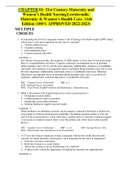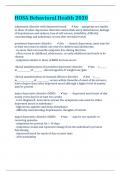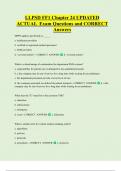Exam 2 Outline
Blood pressure:
- Measure of pressure in arteries; CO X PR = BP (cardiac output X peripheral resistance)
- Systolic: cardiac output
- Diastolic: arterial pressure at rest/ filling
- Take it in both arms
- If L/E pulses are diminished then do leg BP (r/t coarctation)
- Drop in 10-15 systolic with standing and no diastolic change is normal
- Full bladder, smoking, drinking cold/ hot drinks; can increase BP
- Unstable blood pressures; take reading every 5 minutes
Hypertension: “silent killer”
- BP consistently over 139/89 = hypertension
Primary: unknown origin; thiazide or furosemide
Secondary: related to a cause. Ex; CKD, diabetes, OSA, cushings, smoking
Risk factors:
Smoking
Obesity
Sedentary lifestyle
Family history
CAD, CKD
Target Organ Damage:
Can cause MI, stroke, angina, LV hypertrophy, HF, retinopathy, nephropathy
Symptomatic = targeted organ damage (slurring, blurry vision, headache, chest pain)
If hypertensive and not symptomatic: PO meds
If hypertensive with symptoms: IV meds
Diagnostic findings:
● UA
● Electrolytes
● ECG
● Lipid profile (high cholesterol/ HLD)
● Creatinine clearance
Medical Management:
● Eliminate risk factors
● Healthy diet; DASH diet (fruits, veg, low fat, low dairy, high K+/calcium , 1oz etoh)
● Sodium restriction
● Daily exercise
● Diuretics
● ACE, BB, norvasc
, ● GOAL: achieving or maintaining BP 140/90 or lower, if they have CKD or DM
<130/80
BP medications:
Diuretics:
- Thiazides: hydrochlorothiazide, chlorothiazide
- Potassium wasting: furosemide, demadex, bumex
- Potassium sparing: spironolactone
- Used for primary/ essential hypertension
- Tell the client to increase fluids; if not related to HF!
- Monitor renal function (BUN, creatinine), monitor electrolytes
Beta Blockers: metoprolol, labetalol
- Prevents sympathetic stimulation, acts on beta 1 receptors
- Can cause fatigue, increased triglycerides, insulin resistance, prevents MI
Calcium Channel Blockers: amlodipine, verapamil, nifedipine, diltiazem
- Indicated for african americans, AFIB
ACE inhibitors: Lisinopril, enalapril, ramipril
- Acts on angiotensin converting enzyme/ lung tissue
- Affects preload, afterload, ventricular remodeling, nitric oxide
- Monitor angioedema, elevated potassium, cough
ARBS:
- second line of defense, does not cause cough
- Can help with microalbuminuria
Arterial Dilators: Hydralazine, prazosin, clonidine
- Relax vascular smooth muscle
- Clonidine: cannot stop abruptly: can cause rebound hypertension
Statins: Atorvastatin
No grapefruit juice
Monitor CPK and “muscle cramps/pain = rhabdo
,Hypertensive Emergency:
BP >180/120 WITH target organ damage (symptomatic)
Signs:
● Headache with visual changes
● N/V
● Confusion
● Papilledema (eye nerve swelling)
● MI, ischemic changes
Treatment:
GOAL: decrease BP by 25% within first hour, then gradually decrease
6 hour goal: 160/100
Vasodilators IV: Nitroprusside, nicardipine, esmolol, labetalol, hydralazine
Hydralazine: ONLY AFFECTS BP
Hypertensive Urgency:
Increased BP but NO symptoms (can have headache)
Normalize BP within 24-48 hours
Monitor for target organ damage
Treatment:
Fast acting oral agents (BB, ACE, clonidine; rebound hypertension, hydralazine)
, Methods of oxygen delivery:
Nasal cannula:
Low flow: 4-6l/min; causes drying of nasal passages
>4L requires humidification
Simple Mask:
High flow; 6-8L/min
Good for humidification, mouth breathers
Venturi:
Precise oxygenation, specific concentrations
- Accurate and concise FIO2, isn't drying
- Best for COPD patient
Nonrebreather:
- Valve closes with expiration; prevents CO2 from entering reservoir
- 6-10L/min
Complications of oxygen delivery:
- Oxygen toxicity (too high of O2 concentration >48h
● Substernal discomfort
● Paresthesia
● Dyspnea, restlessness
● Fatigue, malaise
Blood pressure:
- Measure of pressure in arteries; CO X PR = BP (cardiac output X peripheral resistance)
- Systolic: cardiac output
- Diastolic: arterial pressure at rest/ filling
- Take it in both arms
- If L/E pulses are diminished then do leg BP (r/t coarctation)
- Drop in 10-15 systolic with standing and no diastolic change is normal
- Full bladder, smoking, drinking cold/ hot drinks; can increase BP
- Unstable blood pressures; take reading every 5 minutes
Hypertension: “silent killer”
- BP consistently over 139/89 = hypertension
Primary: unknown origin; thiazide or furosemide
Secondary: related to a cause. Ex; CKD, diabetes, OSA, cushings, smoking
Risk factors:
Smoking
Obesity
Sedentary lifestyle
Family history
CAD, CKD
Target Organ Damage:
Can cause MI, stroke, angina, LV hypertrophy, HF, retinopathy, nephropathy
Symptomatic = targeted organ damage (slurring, blurry vision, headache, chest pain)
If hypertensive and not symptomatic: PO meds
If hypertensive with symptoms: IV meds
Diagnostic findings:
● UA
● Electrolytes
● ECG
● Lipid profile (high cholesterol/ HLD)
● Creatinine clearance
Medical Management:
● Eliminate risk factors
● Healthy diet; DASH diet (fruits, veg, low fat, low dairy, high K+/calcium , 1oz etoh)
● Sodium restriction
● Daily exercise
● Diuretics
● ACE, BB, norvasc
, ● GOAL: achieving or maintaining BP 140/90 or lower, if they have CKD or DM
<130/80
BP medications:
Diuretics:
- Thiazides: hydrochlorothiazide, chlorothiazide
- Potassium wasting: furosemide, demadex, bumex
- Potassium sparing: spironolactone
- Used for primary/ essential hypertension
- Tell the client to increase fluids; if not related to HF!
- Monitor renal function (BUN, creatinine), monitor electrolytes
Beta Blockers: metoprolol, labetalol
- Prevents sympathetic stimulation, acts on beta 1 receptors
- Can cause fatigue, increased triglycerides, insulin resistance, prevents MI
Calcium Channel Blockers: amlodipine, verapamil, nifedipine, diltiazem
- Indicated for african americans, AFIB
ACE inhibitors: Lisinopril, enalapril, ramipril
- Acts on angiotensin converting enzyme/ lung tissue
- Affects preload, afterload, ventricular remodeling, nitric oxide
- Monitor angioedema, elevated potassium, cough
ARBS:
- second line of defense, does not cause cough
- Can help with microalbuminuria
Arterial Dilators: Hydralazine, prazosin, clonidine
- Relax vascular smooth muscle
- Clonidine: cannot stop abruptly: can cause rebound hypertension
Statins: Atorvastatin
No grapefruit juice
Monitor CPK and “muscle cramps/pain = rhabdo
,Hypertensive Emergency:
BP >180/120 WITH target organ damage (symptomatic)
Signs:
● Headache with visual changes
● N/V
● Confusion
● Papilledema (eye nerve swelling)
● MI, ischemic changes
Treatment:
GOAL: decrease BP by 25% within first hour, then gradually decrease
6 hour goal: 160/100
Vasodilators IV: Nitroprusside, nicardipine, esmolol, labetalol, hydralazine
Hydralazine: ONLY AFFECTS BP
Hypertensive Urgency:
Increased BP but NO symptoms (can have headache)
Normalize BP within 24-48 hours
Monitor for target organ damage
Treatment:
Fast acting oral agents (BB, ACE, clonidine; rebound hypertension, hydralazine)
, Methods of oxygen delivery:
Nasal cannula:
Low flow: 4-6l/min; causes drying of nasal passages
>4L requires humidification
Simple Mask:
High flow; 6-8L/min
Good for humidification, mouth breathers
Venturi:
Precise oxygenation, specific concentrations
- Accurate and concise FIO2, isn't drying
- Best for COPD patient
Nonrebreather:
- Valve closes with expiration; prevents CO2 from entering reservoir
- 6-10L/min
Complications of oxygen delivery:
- Oxygen toxicity (too high of O2 concentration >48h
● Substernal discomfort
● Paresthesia
● Dyspnea, restlessness
● Fatigue, malaise







